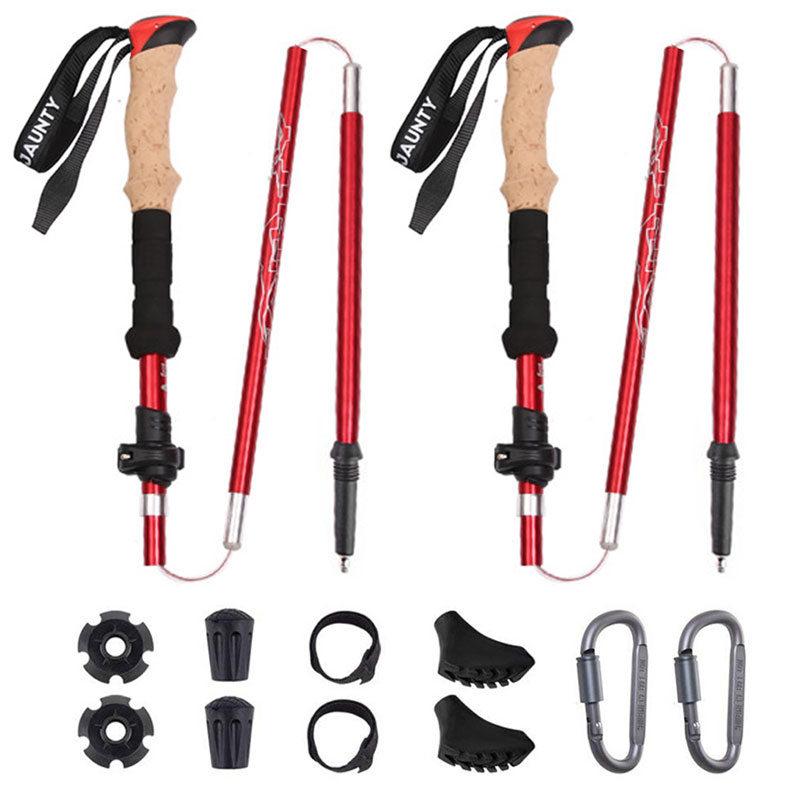1.Handle of
the trekking poles
The handle is usually made of EVA, rubber, cork, plastic and other materials. Each material has the following characteristics: EVA: comfortable grip, full and elastic, not affected by seasons, and the material has sweat absorption function; Rubber: full grip, hard in winter, easy to crack, no sweat absorption function, easy to slide in summer; Cork: full grip, not affected by season. The material has sweat absorption function and is easy to wear and desquamate; Plastic: poor grip, easy to crack in winter and easy to slide in summer, but the cost is low, cheap and convenient.
2.Wristbands of
the trekking poles
This is the most important part to consider when purchasing a mountaineering stick. Because the mutual transmission between the mountaineering stick and the user's physical strength is mainly through the wristband, we should consider whether it has the following characteristics when selecting a high-quality wristband: the middle of the wristband is wide and both sides are narrow, which can prevent strangulation; The wristband adjusting buckle is arranged at the connection with the climbing stick, which does not contact with the hand to prevent hand crushing; The inner side of the wristband is made of suede anti friction material to effectively protect the skin contacted by the wristband.
3. Strut of
the trekking poles
The material of strut is usually made of aluminum alloy, carbon fiber, titanium alloy, wood, steel and other materials, among which aluminum alloy and carbon fiber are the most widely used. Several materials have the following characteristics: aluminum alloy: strong and durable, low price, heavier than carbon fiber and titanium alloy and easy to corrosion; Carbon fiber: light weight, good elasticity and toughness, high strength ratio, corrosion resistance and high price; Titanium alloy: light weight, good material elasticity and strength, corrosion resistance and high price.
4. Locking system of
the trekking poles
The locking system is the core safety component of a mountaineering stick. 90% of the mountaineering stick problems are caused by the failure of the locking system. Cheap climbing sticks generally use easily deformable ordinary plastic parts, while high-end climbing sticks use high hard engineering plastics (crystal plastics) and are precision cut. At the same time, the aluminum alloy mountaineering stick will be equipped with a shock absorption system together with the locking system. As a spring component, the shock absorber system can effectively buffer the impact force and reduce the pressure on the knee when going downhill. However, because the spring will absorb the thrust when going uphill, it will consume additional physical strength when walking for a long time. In addition, the spring components with poor material are prone to rust, fracture, slippage, etc., causing the buckle or failure of the locking system. The climbing stick made of carbon fiber and titanium alloy has good elasticity and toughness, so it can achieve balanced shock absorption without setting up shock absorption system.
5. Mud support of
the trekking poles
The mud support can prevent the climbing stick from falling into the mud. However, there are many thorns and shrubs in the climbing environment, and the mud support will hinder the convenience of action. Therefore, it should be noted that the mud support can be disassembled quickly so as not to cause trouble.
6. Stick tip of
the trekking poles
The stick tip is made of rubber head, iron, carbon tungsten steel, etc. Carbon tungsten steel is the hardest, the most expensive, and rubber head is the cheapest, but it can't cope with rugged outdoor terrain, and its wear resistance is not as good as carbon tungsten steel head. The common patterns on the tip of the stick include mesh pattern, diamond pattern, grid pattern, etc., among which the diamond pattern has the best skid resistance and penetration.

